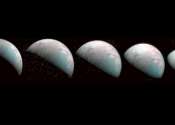NASA Juno takes first images of jovian moon Ganymede's north pole
On its way inbound for a Dec. 26, 2019, flyby of Jupiter, NASA's Juno spacecraft flew in the proximity of the north pole of the ninth-largest object in the solar system, the moon Ganymede. The infrared imagery collected by ...









